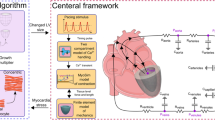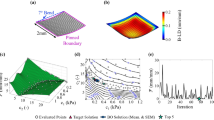Abstract
This study describes a multidimensional 3D/lumped parameter (LP) model which contains appropriate inflow/outflow boundary conditions in order to model the entire human arterial trees. A new extensive LP model of the entire arterial network (48 arteries) was developed including the effect of vessel diameter tapering and the parameterization of resistance, conductor and inductor variables. A computer aided-design (CAD) algorithm was proposed to efficiently handle the coupling of two or more 3D models with the LP model, and substantially lessen the coupling processing time. Realistic boundary conditions and Navier-Stokes equations in healthy and stenosed models of carotid artery bifurcation (CAB) were used to investigate the unsteady Newtonian blood flow velocity distribution in the internal carotid artery (ICA). The present simulation results agree well with previous experimental and numerical studies. The outcomes of a pure LP model and those of the coupled 3D healthy model were found to be nearly the same in both cases. Concerning the various analyzed 3D zones, the stenosis growth in the ICA was not found as a crucial factor in determining the absorbing boundary conditions. This paper demonstrates the advantages of coupling local and systemic models to comprehend physiological diseases of the cardiovascular system.

Similar content being viewed by others
References
Alastruey, J., Parker, K.H., Peiró, J., et al.: Analysing the pattern of pulse waves in arterial networks: A time-domain study. J. Eng. Math. 64, 331–351 (2009)
Alastruey, J.: On the mechanics underlying the reservoir-excess separation in systemic arteries and their implications for pulse wave analysis. Cardiovasc. Eng. 10, 176–189 (2010)
Avolio, A.P.: Multi-branched model of the human arterial system. J. Med. Biol. Eng. Comput. 18, 709–718 (1980)
Azer, K.: A one-dimensional model of blood flow in arteries with friction, convection and unsteady taylor diffusion based on the womersley velocity profile, [Ph.D. Thesis]. New York University, New York (2006)
Formaggia, L., Lamponi, D., Quarteroni, A.: One-dimensional models for blood flow in arteries. J. Eng. Math. 47, 251–276 (2003)
Formaggia, L., Lamponi, D., Tuveri, M., et al.: Numerical modeling of 1D arterial networks coupled with a lumped parameters description of the heart. Comput. Methods Biomech. Biomed. Engin. 9, 273–288 (2006)
Hassani, K., Navidbakhsh, M., Rostami, M.: Simulation of aorta artery aneurysms using active electronic circuit. Am. J. Apll. Sci. 4, 203–210 (2007)
Johnson, D.A., Rose, W.C., Edwards, J.W., et al.: Application of 1D blood flow models of the human arterial network to differential pressure predictions. J. Biomech. 44, 869–876 (2011)
Lee, T.C., Huang, K.F., Hsiao, M.L., et al.: Electrical lumped model for arterial vessel beds. J. Comput. Methods Programs Biomed. 73, 209–219 (2004)
Reymond, P., Merenda, F., Perren, F., et al.: Validation of a one-dimensional model of the systemic arterial tree. Am. J. Physiol. Heart Circ. Physiol. 297, 208–222 (2009)
Sherwin, S.J., Franke, V., Peiró, J., et al.: One-dimensional modelling of a vascular network in space-time variables. J. Eng. Math. 47, 217–250 (2003)
Steele, B.N., Wan, J., Ku, J.P., et al.: In vivo validation of a one-dimensional finite-element method for predicting blood flow in cardiovascular bypass grafts. IEEE Trans. Biomed. Eng. 50, 649–656 (2003)
Steele, B.N., Olufsen, M.S., Taylor, C.A.: Fractal network model for simulating abdominal and lower extremity blood flow during resting and exercise conditions. Comput. Methods Biomech. Biomed. Engin. 10, 39–51 (2007)
Chen, J., Wang, S., Ding, G., et al.: The effect of aneurismal-wall mechanical properties on patient-specific hemodynamic simulations: two clinical case reports. Acta Mech. Sin. 25, 677–688 (2009)
Johnston, B.M., Johnston, P.R., Corney, S., et al.: Non-Newtonian blood flow in human right coronary arteries: transient simulations. J. Biomech. 39, 1116–1128 (2006)
Morbiducci, U., Gallo, D., Massai, D., et al.: On the importance of blood rheology for bulk flow in hemodynamic models of the carotid bifurcation. J. Biomech. 44, 2427–2438 (2011)
Shahcheraghi, N., Dwyer, H.A., Cheer, H.A., et al.: Unsteady and three-dimensional simulation of blood flow in the human aortic archaortic arch. J. Biomech. Eng. 124, 378–387 (2002)
Sheidaei, A., Hunley, S.C., Zeinali-Davarani, S., et al.: Simulation of abdominal aortic aneurysm growth with updating hemodynamic loads using a realistic geometry. J. Med. Eng. Phys. 33, 80–88 (2011)
Tada, S., Tarbell, J.M.: A Computational study of flow in a compliant carotid bifurcation-stress phase angle correlation with shear stress. Ann. Biomed. Eng. 33, 1202–1212 (2005)
Vincent, P.E., Plata, A.M., Hunt, A.A.E., et al.: Blood flow in the rabbit aortic arch and descending thoracic aorta. J. R. Soc. Interface. 8, 1708–1719 (2011)
Zhang, X., Yao, Z., Zhang, Y., et al.: Experimental and computational studies on the flow fields in aortic aneurysms associated with deployment of AAA stent-grafts. Acta Mech. Sin. 23, 495–501 (2007)
Marshall, I., Zhao, S., Papathanasopoulou, P., et al.: MRI and CFD studies of pulsatile flow in healthy and stenosed carotid bifurcation models. J. Biomech. 37, 679–687 (2004)
Giddens, D.P., Zarins, C.K., Glagov, S.: The role of fluid mechanics in the localization and detection of atherosclerosis. J. Biomech. Eng. 115, 588–594 (1993)
Bressloff, N.W.: Parametric geometry exploration of the human carotid artery bifurcation. J. Biomech. 40, 2483–2491 (2007)
Fan, Y., Jiang, W., Zou, Y., et al.: Numerical simulation of pulsatile non-Newtonian flow in the carotid artery bifurcation. Acta Mech. Sin. 25, 249–255 (2009)
Gijsen, F.J.H., van de Vosse, F.N., Janssen, J.D.: The influence of the non-Newtonian properties of blood o the flow in large arteries: steady flow in a carotid bifurcation model. J. Biomech. 32, 601–608 (1999)
Perktold, K., Resch, M., Florian, H.: Pulsatile non-Newtonian flow characteristics in a three-dimensional human carotid bifurcation model. J. Biomech. Eng. 113, 464–475 (1991)
Rindt, C.C.M., van Steenhoven, A.A.: Unsteady flow in a rigid 3-D model of the carotid artery bifurcation. J. Biomech. 118, 90–96 (1996)
Ghalichi, F.: Pulsatile laminar and turbulent blood flow simulation in large stenosed arteries and stenosed carotid artery bifurcation. [PhD Thesis]. Laval University, Quebec (1998)
Cheung, S.C., Wong, K.K., Yeoh, G.H., et al.: Experimental and numerical study on the hemodynamics of stenosed carotid bifurcation. Australas. Phys. Eng. Sci. Med. 33, 319–328 (2010)
Long, Q., Xu, X.Y., Ramnarine, K.V., et al.: Numerical investigation of physiologically realistic pulsatile flow through arterial stenosis. J. Biomech. 34, 1229–1242 (2001)
Massai, D., Soloperto, G., Gallo, D., et al.: Shear-induced platelet activation and its relationship with blood flow topology in a numerical model of stenosed carotid bifurcation. Eur. J. Mech. B-Fluid. 35, 92–101 (2012)
Moayeri, M.S., Zendehbudi, G.R.: Effects of elastic property of the wall on flow characteristics through arterial stenoses. J. Biomech. 36, 525–535 (2003)
Stroud, J.S., Berger, S.A, Saloner, D.: Influence of stenosis morphology on flow through severely stenotic vessels: implications for plaque rupture. J. Biomech. 33, 443–455 (2000)
Urquiza, S.A., Blanco, P.J., Vénere, M.J., et al.: Multidimensional modelling for the carotid artery blood flow. J. Comput. Methods Appl. Mech. Engrg. 195, 4002–4017 (2006)
Lagan`a, K., Balossino, R., Migliavacca, F., et al.: Multiscale modeling of the cardiovascular system: application to the study of pulmonary and coronary perfusions in the univentricular circulation. J. Biomech. 38, 1129–1141 (2005)
Moura, A.: The geometrical multiscale modelling of the cardiovascular system: Coupling 3D and 1D FSI models, [Ph.D. Thesis]. Politecnico di Milano, Milan (2007)
Balossino, R., Pennati, G., Migliavacca, F., et al.: Computational models to predict stenosis growth in carotid arteries: which is the role of boundary conditions? Comput. Methods Biomech. Biomed. Engin. 12, 113–123 (2009)
Blanco, P.J., Feijóo, R.A., Urquiza, S.A.: A unified variational approach for coupling 3D-1D models and its blood flow applications. Comput. Methods Appl. Mech. Engrg. 196, 4391–4410 (2007)
Formaggia, L., Gerbeau, J.F., Nobile, F., et al.: On the coupling of 3D and 1D Navier-Stokes equations for flow problems in compliant vessels. Comput. Methods Appl. Mech. Engrg. 191, 561–582 (2001)
Janela, J., Moura, A., Sequeira, A.: Absorbing boundary conditions for a 3D non-Newtonian fluid-structure interaction model for blood flow in arteries. J. Eng. Sci. 48, 1332–1349 (2010)
Liang, F., Fukasaku, K., Liu, H., et al.: A computational model study of the influence of the anatomy of the circle of willis on cerebral hyperperfusion following carotid artery surgery. Biomed Eng Online 10:84 (2011)
Nobile, F.: Coupling strategies for the numerical simulation of blood flow in deformable arteries by 3D and 1D models. J. Math. Comput. Mod. 49, 2152–2160 (2009)
Passerini, T., De Luca, M.R., Formaggia, L., et al.: A 3D/1D geometrical multiscale model of the cerebral vasculature. J. Eng. Math. 64, 319–330 (2009)
Qin, K., Jiang, Z., Sun, H., et al.: A multiscale model for analyzing the synergy of CS and WSS on the endothelium in straight arteries. Acta Mech. Sin. 22, 76–83 (2006)
Quarteroni, A., Veneziani, A.: Analysis of a geometrical multiscale model based on the coupling of ode’s and pde’s for blood flow simulation. Multiscale Model Simul. 1, 173–195 (2003)
Ruan, W.: A coupled system of ODEs and quasilinear hyperbolic PDEs arising in a multiscale blood flow model. J. Math. Anal. Appl. 343, 778–798 (2008)
Sankaran, S., Esmaily Moghadam, M., Kahn, A.M., et al.: Patient-specific multiscale modeling of blood flow for coronary artery bypass graft surgery. Ann. Biomed. Eng. (2012) DOI 10.1007/s10439-012-0579-3
Liu, Z.Y., Zhou, Y.S.: A coupling model of left ventricle and arterial system. Acta Mech. Sin. 5, 285–292 (1989)
Formaggia, L., Nobile, F., Quarteroni, A., et al.: Multiscale modelling of the circulatory system: A preliminary analysis. Comput. Visual. Sci. 2, 75–83 (1999)
Quarteroni, A., Ragni, S., Veneziani, A.: Coupling between lumped and distributed models for blood flow problems. J. Comput. Visual. Sci. 4, 111–124 (2001)
Shi, Y., Lawford, P., Hose, R.: Review of zero-D and 1-D models of blood flow in the cardiovascular system. Biomed. Eng. 10:33 (2011)
Bharadvaj, B.K., Mabon, R.F., Giddens, D.P.: Steady flow in a model of the human carotid bifurcation. Part I: Flow visualization. J. Biomech. 15, 349–362 (1982)
Rideout, V.C.: Mathematical and Computer Modeling of Physiological Systems. Prentice Hall, NewYork (1991)
Author information
Authors and Affiliations
Corresponding author
Rights and permissions
About this article
Cite this article
Kashefi, A., Mahdinia, M., Firoozabadi, B. et al. Multidimensional modeling of the stenosed carotid artery: A novel CAD approach accompanied by an extensive lumped model. Acta Mech Sin 30, 259–273 (2014). https://doi.org/10.1007/s10409-014-0047-4
Received:
Revised:
Accepted:
Published:
Issue Date:
DOI: https://doi.org/10.1007/s10409-014-0047-4




